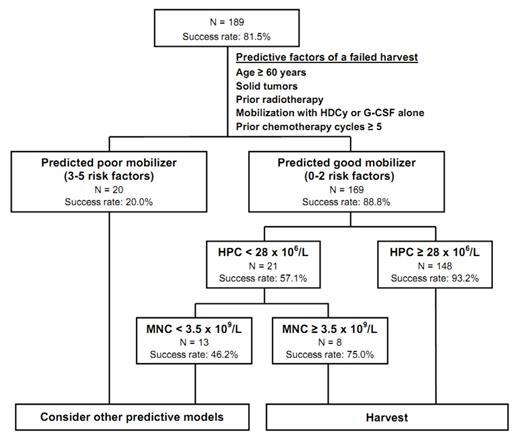Abstract
Background and Objectives
Enumeration of hematopoietic progenitor cells (HPC) using an automated hematology analyzer provides rapid, inexpensive, and less technically dependent prediction of peripheral blood stem cell (PBSC) mobilization. This study aimed to incorporate HPC enumeration along with other predictors for optimizing a successful harvest.
Materials and Methods
Between 2007 and 2012, 189 consecutive patients who proceeded to PBSC harvesting with a preharvest HPC ≥ 20 x 106 /L were recruited. A failed PBSC mobilization was defined as < 2 x 106 CD34+ cells/kg. Variables predicting a successful harvest identified by multivariate logistic regression and correlation analysis were subjected to classification and regression tree (CART) analysis.
Results
A total of 154 (81.5%) patients successfully achieved mobilization of CD34+ cells (median 8.18 x 106 CD34+ cells/kg). Five independent host predictors including age ≥ 60, a diagnosis of solid tumor, prior chemotherapy cycles ≥ 5, prior radiotherapy, and mobilization with G-CSF alone or high-dose cyclophosphamide, as well as laboratory markers including HPC and mononuclear cell (MNC) counts, were used for CART analysis. The number of host predictors with a cutoff at two, HPC cutoff at 28 x 106/L and MNC cutoff at 3.5 x 109 /L were best discriminative for successful prediction. In the decision tree algorithm, patients predicted as good mobilizers (0 to 2 risk factors) had a higher success rate (150/169, 88.8%) than that (4/20, 20.0%) of those predicted as poor mobilizers (3-5 risk factors). Moreover, patients predicted as good mobilizers and further with a HPC enumeration ≥ 28 x 106/L had a high probability of achieving successful mobilization (138/148, 93.2%).
Conclusion
Our CART algorithm incorporating host predictors, HPC enumeration and MNC count may improve prediction and thus increase the success of PBSC mobilization. Further prospective validation is necessary.
No relevant conflicts of interest to declare.
Author notes
Asterisk with author names denotes non-ASH members.


This feature is available to Subscribers Only
Sign In or Create an Account Close Modal